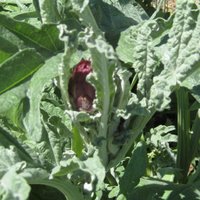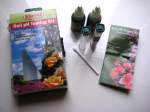Home › Home vegetable garden › Growing globe artichokes as annuals
Growing Globe Artichokes As Annuals

Growing globe artichokes as perennials is all very well if you live in a region where they are not likely to be killed off by heavy winter frosts. But what if your climate is not ideal?
You may still be able to grow these gourmet vegetables by treating them as annuals rather than as perennials.
To produce those delicious flower buds, artichokes require a period of 'vernalization' - exposure to cool temperatures.
Think of it this way.
Artichokes are adapted to mild coastal climates without extremes of heat and cold.
Left to their own devices, globe artichokes flower in summer and then produce seed which germinates.
The seedlings are then exposed to cooler temperatures over winter before resuming growth the following spring and going on to flower in the summer.
Vernalization is the technique of making the plants believe that they have undergone a winter season and 'forcing' them into producing flower buds in the same year that they are planted.
In practical terms this means starting the seeds off early in the year in a warm indoor environment and then exposing them to cool spring temperatures to mimic the mild maritime winter they are adapted to.
It's not as complicated as you may be thinking...
Choose and Prepare the Planting Site
Before you start growing globe artichokes, it pays to choose and prepare the eventual planting site carefully.
Artichokes need to be in full sun for most of the day and sheltered from cold winds.
The soil should be fertile and free draining with a pH around neutral if possible. Add plenty of well rotted compost or manure and improve drainage if necessary by adding grit (see improving garden soil for more information).
Growing globe artichokes in established 'no dig' vegetable garden beds and in raised beds
Choose the Right Varieties
This is important when growing globe artichokes as annuals.
The hybrid variety Imperial Star has been bred specifically for annual production in short season regions and needs only a short vernalization period of 8-10 days. You can expect to be harvesting Imperial Star 80-90 days after setting out the plants in their cropping positions. There should be relatively few seedlings that do not come true to type.
Another variety worth looking out for is Emerald. This can be grown as an annual and seems to need very little vernalization. It matures a couple of weeks later than Imperial Star. Interestingly it is reportedly frost hardy down to 0 degrees F (-17 degrees C) which suggests that it may survive as a perennial, even in more northerly regions.
The traditional varieties, such as Green Globe, require a long period of vernalization, and are more suitable for growing as perennials, although they can be grown as annuals. Be prepared for a high proportion of the seeds not coming true to type.
Sowing and Germinating Seeds
Globe artichokes do not always come true to type from seed. Sow more seeds than you will need to compensate for this.
Sow the seed in late winter or early spring, eight to ten weeks before your last expected spring frost.
Sow the seed 1/4 inch deep in trays or modules of moist, good quality potting compost with some added grit or vermiculite to aid drainage. (I prefer to use modules as it is easier to pot the seedlings on).
For the maximum germination rate keep the compost at around 21-24 degrees C (70-75 degrees F) to promote germination. This can be done in a heated greenhouse or by using a propagator or heat pad. If this is not possible simply keep them at room temperature on a sunny indoor windowsill. Germination may take up to three weeks.
Keep the compost evenly moist at all times - not too dry and not too wet.
Once the seedlings emerge and are large enough to handle, pot them on into 9cm (3-4in) pots.
Continue to keep them in a warm, bright environment until three to four true leaves have formed. The ideal temperature at this stage is around 15-18 degrees C (60-65 degrees F) in the daytime and 10-13 degrees C (50-55 degrees F) at night - pretty much room temperature.
Vernalization and Planting Out
Now for the vernalization period!
Place the young plants outside in a cold frame, or use cloches or a plastic tunnel, and gradually harden off for a further two weeks or so. The aim is to expose them to temperatures roughly in the range 4-10 degrees C (40-50 degrees F) to simulate a mild winter. If frost is forecast cover them up at night.
Once you are fairly confident that all danger of heavy frosts has passed, plant out the young artichokes in their cropping positions leaving 60-90cm (2-3ft) between plants and at least 90cm (3ft) between rows.
When you remove the artichokes from their pots carefully straighten the tap root that will be coiled up and make sure that you make each planting hole deep enough to accommodate it.
Keep an eye on the local weather forecast and if a late frost is predicted, use straw or horticultural fleece to protect the plants.
Water the plants when necessary to keep them evenly moist and apply a good thick layer of organic mulch around them. This not only conserves moisture and keeps the weeds down, but it also keeps the roots cool.
Pests and Diseases
Pests and diseases aren't usually too much of a problem when growing globe artichokes.
The main problem seems to be blackfly which sometimes attack the developing buds. Wipe them off with a damp cloth as soon as you spot them.
Slugs and snails may also attack the young foliage so set up some beer traps nearby to catch them.
When and How to Harvest
If you're growing globe artichokes as annuals, you can expect the flower buds to start forming from late summer into fall. It is important to keep them well watered at this time to allow the buds to swell.
Harvest the buds when they are firm and plump, just before the bottom scales or bracts start to open outwards. Use a sharp knife to cut through the stem a couple of inches below the bud.
Harvest the main heads first to encourage the production of secondary buds.
The heads are best used fresh from the plant for the finest flavour but you can store them for a few days in the refrigerator if necessary.
For More Information...
More information on vegetable growing can be found at creating a successful home vegetable garden.
If you're new to vegetable gardening, do try these easy vegetables to grow.
Another vegetable that is in the gourmet league is sprouting broccoli. It is delicious, nutritious and very easy to grow. Growing broccoli gives you all the information you need.
Home › Home vegetable garden › Growing globe artichokes as annuals
